NORTH WALES COAST RAILWAY:NOTICE BOARD
Rheilffordd arfordir gogledd Cymru: Hysbysfwrdd
19 April 2016
 Last issue
Last issue Archive
Archive Tweet
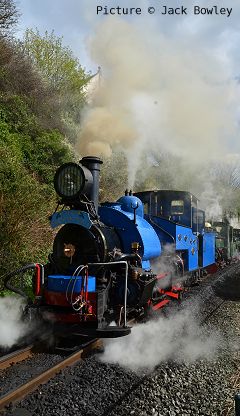
Tweets by @NWrail1
Contributions and comments are encouraged: see the Contributions Page
This list may be out of date if you are reading an archived issue. For full information visit our Calendar page.
April 2016
Friday 22 April Chester MP's Rail User Forum
Friday 29 April Great Western Society NW Branch A tribute to Tom Lewis, Railway cameraman 1947-1970, Paul Shackcloth.
May 2016
Tuesday 3 May North Wales Railway Circle AGM and Photographic Competition.
Thursday 12 May Llandudno and Conwy Valley Railway Society Ray Bailey: Steam into Holywell
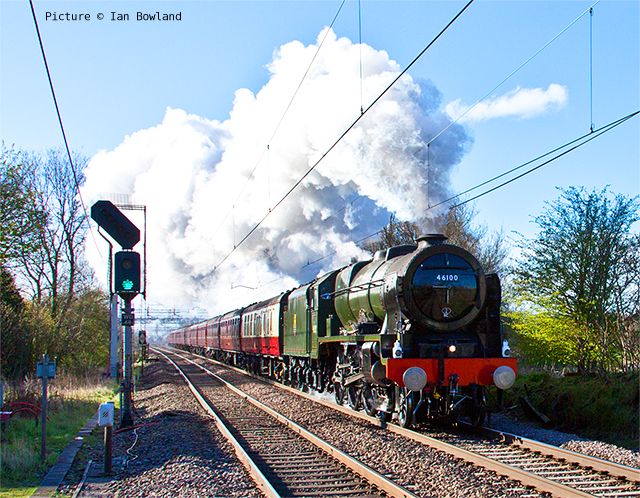
46100 Royal Scot passing through Winsford on 16 April with 'The Scot Commemorative' charter running from Crewe via Whitehaven to Carlisle, returning via Shap to Crewe (Ian Bowland). The route via the Cumbrian Coast line was adopted as the Settle - Carlisle line is closed north of Appleby.
Run out of time - some of the many contributions! Some are below, others held over till next week. - Charlie
Llanddulas viaduct
Many thanks to those who have responded to our query about the most recent rebuilding of Llanddulas viaduct. We can now tell you that the re-construction work was planned for
Sunday 20 October to - Wednesday 30 October 1974 with an additional day booked on Sunday 3 November. Was this timetable adhered to, we wonder.
Mark Lamb writes: 'What may be of interest is the method of working trains whilst it was rebuilt. A temporary signalbox was constructed at Llanddulas, working to Llysfaen and Abergele either side, with protecting home and distant signals. The track over the viaduct was interlaced - no points - on the unrebuilt side while the other side was converted to concrete. I don't know whether the Up or the Down was done first. Once the new side had been built, the interlacing was switched over until that had been completed. The track was then reinstated as plain line, Llandulas temporary signalbox abolished and the normal block section restored.'
If anyone photographed this operation in progress, it would be good to hear from them.
Freight scenes
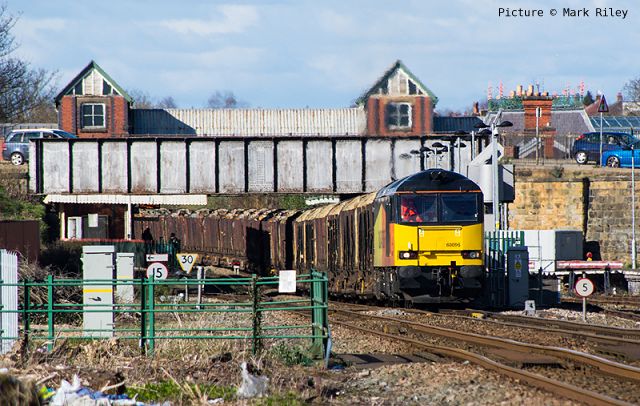
On Saturday April 16, 60096 gets under way from Wrexham General at 16:55 with Train 6J37 Carlisle - Chirk logs. Picture by Mark Riley.
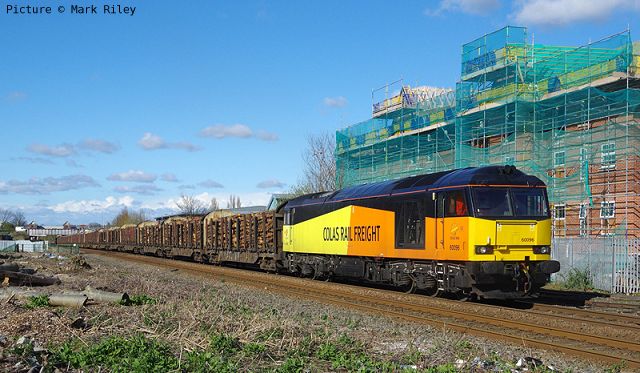
60 096 approaches Croes Newydd Level Crossing, passing the new Bellway 'Cobden Mill' development of 2-bedroom apartments and 3-bedroom houses (if anyone can afford them!) The level crossing now gives a view which wasn't possible a few years ago - especially good on sunny afternoons like this. The clearance of undergrowth and trees has really opened up the area, and future residents of the new apartments will get some unique views of this stretch of the railway (Mark Riley).

37 059 and 57 003 with FNA wagons 550030,550027 & 550050 pass Flint with the 14:58 Valley - Crewe on 15 April, running 46 minutes early (as usual). Picture by Tim Rogers. The same pair, having proceeded from Crewe to Sellafield, appear in our 'Scot Commemorative' report below.
Users' Meeting in Chester
There will be a meeting of the Chester MP's Rail User Forum on Friday 22 April at 6pm in the upstairs room of the Town Crier Pub opposite Chester Train Station.
Local councillor Richard Beecham has listed some key points raised at the last meeting:
Re-Doubling Chester to Wrexham servicePlenty to go on there! In the meeting there will an election for a new Chairperson for the Group and a review of the points made above so that a working plan can be established and/or some actions that the group wishes to take forward via the MP's office and the Council in the future.
New routes: Crewe-Chester-Holyhead, Shrewsbury-Newport, Wrexham-Bidston,
Birmingham-Shrewsbury-Wrexham-Chester-Liverpool Parkway-Liverpool Lime Street
New Wrexham North Parkway station to anticipate increased demand
Maximum exploitation of Halton Curve for Through Services
Station re/openings in consideration of new housing as people are travelling further
Potential for Rail Freight to Holyhead and Ireland
More stations for suburban and rural areas e.g. Beeston
Stations in City centre, possibly Garden Quarter or Northgate
Parkway station
Better connectivity and timing, particularly between Wrexham-Manchester
Faster trains, particularly between Liverpool-Manchester
Improve local services, particularly Arriva Wales
HS2 will not help Chester
UK not suitable for high speed
Improve local services, particularly Arriva Wales
Weekend trains to Manchester from Chester, especially sat mornings are overcrowded
Improved frequency to Manchester from Chester on weekdays
Cost to Manchester from Chester
Against HS2, funding better spent on improving existing services
Arriva Trains N.Wales and Midlands trains are poor to Manchester
Direct service to Manchester
Wrexham-Liverpool South Parkway (via Halton Curve)
Direct from Wrexham-Manchester or better services from Chester
Capacity at Chester station
Economic opportunities from proximity to HS2
Better cross border engagement
Opportunity or threat of Refranchise of Wales and Borders franchise
Overhead line from Crewe-Chester for electric train services to Euston.
Better parking at Chester station.
Direct services to Manchester and Liverpool Airports, including the Halton Curve
English Train operating company in Chester?
Nationalisation
Disability issues
Tourism and heritage
Steam events
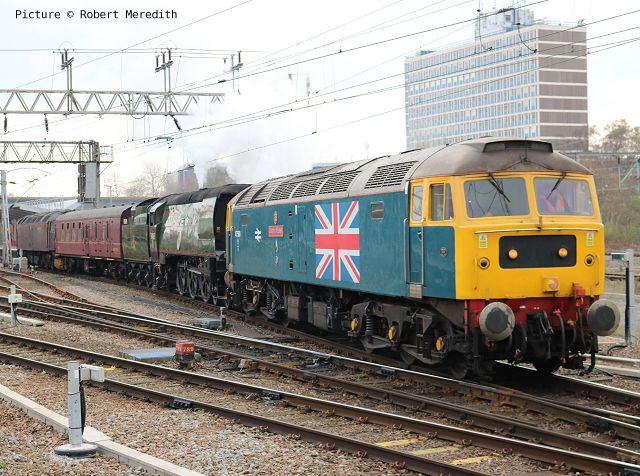
Bulleid pacific 34067 Tangmere, featured in a West Coast Railways Southall to Carnforth move on 14 April. Robert Meredith's picture taken at Crewe shows that the engine was in 'light steam.with a support coach attached, but being towed by 47 580 County of Essex and with 47 760 at the rear The loco was heading back to Carnforth for maintenance.
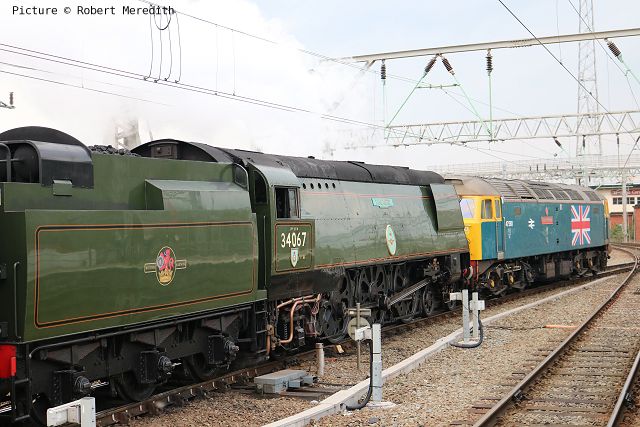
The train had paused at Crewe for the steam loco to take on water. 34067 had been scheduled on 2 April to work the 'Cathedrals Express' from London to Chester, but following a late change to the tour itinerary, 45699 Galatea provided the steam haulage from Crewe to Chester via Shrewsbury (Robert Meredith).
Unfortunately another 'safety incident' involving a West Coast Railways train occurred on 13 April at Bath Spa station when a diesel-hauled excursion returning from Bristol to London came to a stand with some of the rear coaches not against the platform. Stewards in the front coaches opened the doors and people began boarding, only for the train to re-start and move forward to its proper position with some doors still open.
Aboard the Scot Commemorative - pictures by Anthony Thomas
Anthony Thomas travelled on the 'Scot Commemorative' charter, seen above preparing for departure at Crewe, As on some other West Coast Railways trains, a little man rode on the front of the loco, the significance of which escapes us at present.
The plaque detailing the loco's adventures in America.
This train was planned as a re-run of the 'Scot Commemorative' special which ran under the auspices of the Railway Correspondence & Travel Society (Lancashire & North West Branch) on 13 February 1965, intended as a farewell to the 'Royal Scot' locos which had done good work on the West Coast Main Line, although - as is often the case with such matters - in the event the class last in service a little longer. The locomotive used on that occasion was 46115 Scots Guardsman, which also survives today in preservation; 46160 Queen Victoria's Rifleman had been rostered for the 1965 train but had failed with an overheated axlebox a few days earlier.
Pausing at Preston. The 1965 train used a different outbound route, from Wigan North Western - via Boars Head Jn, White Bear, Chorley, Cherry Tree and Blackburn to Hellifield and the Settle - Carlisle line, returning via the direct route over Shap and through Preston.

Portrait at Preston. Unlike many charters, no headboard with the name of the train was carried, but then neither did one appear on the 1965 version, which carried only the 'headcode' 1X80 and a small RCTS badge.
A stop for water on the goods line by Carnforth depot. Note the hose draped over two sidings and through the security fence to the road tanker visible on the left. An hour (10:44 to 11:46) was allowed for this operation.
Carnforth station, with interested members of the public in evidence.
The 1965 participants enjoyed a visit to Hellifield shed where some preserved locos were stored at that time. In 2006, there was a view of 34067 Tangmere ...
... and some diesels including 37 516 Loch Laidon in the West Coast Railways Carnforth depot ...
... and later a glimpse through the Sellafield high-security fence of DRS locos 57 003 and 37 059.
A further water stop was made at Sellafield station enabling participants to stretch their legs.
Again the watering had to be done by tanker, as the water crane no longer functions. Until 2011, steam specials from the south would commonly terminate at Sellafield, using a triangle of lines (similar to the one at Valley) belonging to British Nuclear Fuels to turn the loco for the return journey, but since then this has been considered to be a security risk.
The gloss finish of the loco seen to good effect at Sellafield. Charter trains via this route are not common, perhaps because the length of time needed - four hours from Carnforth to Carlisle including the water stop at Sellafield. Passengers in search of rare track do get to traverse the short Barrow-in-Furness avoiding line.
Flashback: A view by Harold Bowtell from the Manchester Locomotive Society archive showing 46115 at Hellifield on the 1965 train. See The Railtour Files for details of this and many other railtours.
Irish Journey - report by Alan Crawshaw
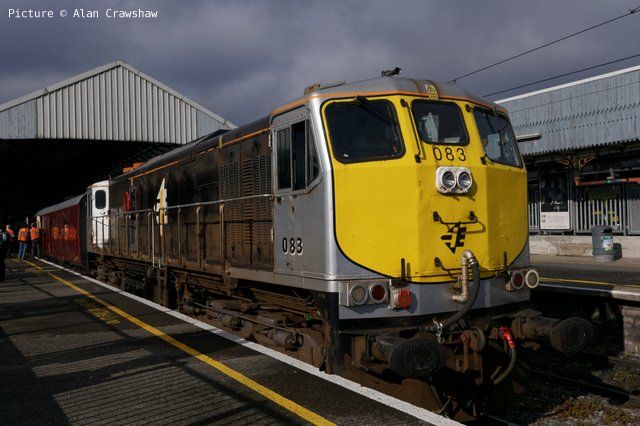
Rowan and I were booked on the weekend Irish Railway Record Society tour to celebrate the 70th anniversary of the IRRS and the 40th anniversary of the General Motors 071 class locomotives. This would have been our first opportunity to experience the reopened Western Rail Corridor section but our railtour jinx struck again in the form of storm Frank, the section between Limerick and Ennis is not expected to reopen until mid-May following the flood damage. With no option to cancel, we took the ferry on Friday, staying overnight before Saturday's 10:20 departure which left Dublin Connolly (above) on time behind 083.
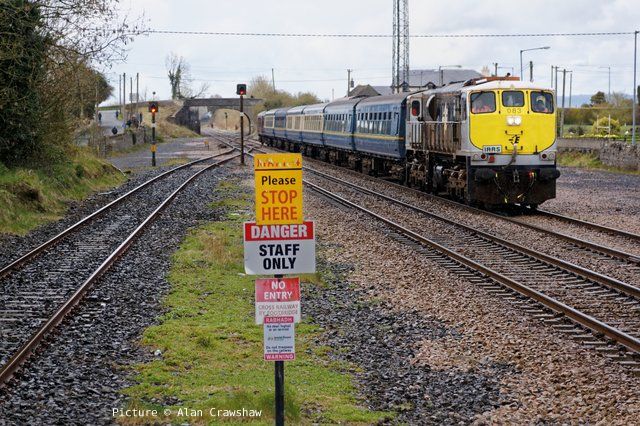
We had to alight at Ballybrophy (above) for the train to continue on to run round at a quarry siding as such facilities have been removed at the station, this was to allow us to reach Limerick via the slow single track line through Nenagh. This has been starved of investment, the sparse service and speed restrictions deter passengers and the line is under threat of closure. It's a delightful trundle for the enthusiast.
Limerick is a terminus station, a convenient place to change locomotives so 083 was detached for 076 to take us back out and onto Cork where it ran round for an evening ride for the overnight stay in Killarney.
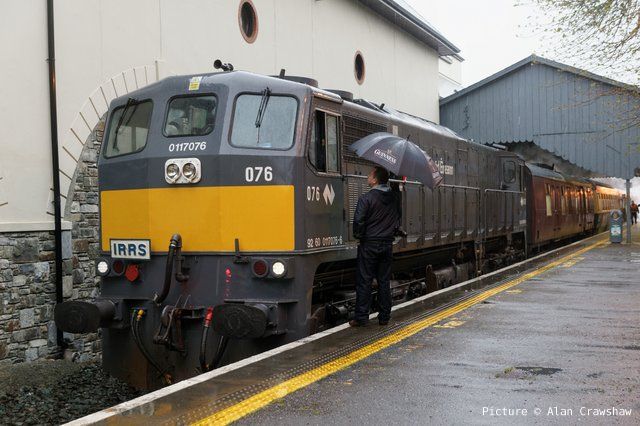
There was a choice of a Sunday lie in or an 08:35 ride to Tralee and back, luckily our hotel served breakfast from 07:30 so we were able to eat first. The temperature was only 2Ί C with a severe wind chill making it feel colder than my visit to Iceland in March last year. We returned to pick up the late sleepers at Killarney (above) then on through the snowfields of Kerry to Limerick Junction with a half hour layover to allow service trains to pass before ...
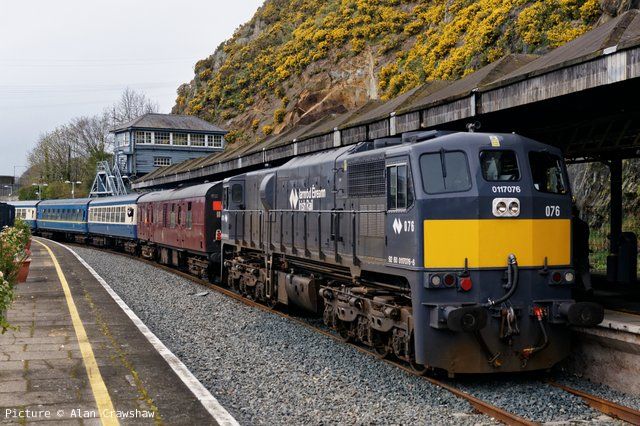
... we could gain the line to Waterford (above) via Tipperary which sees only two daily service trains in each direction, none on Sunday.
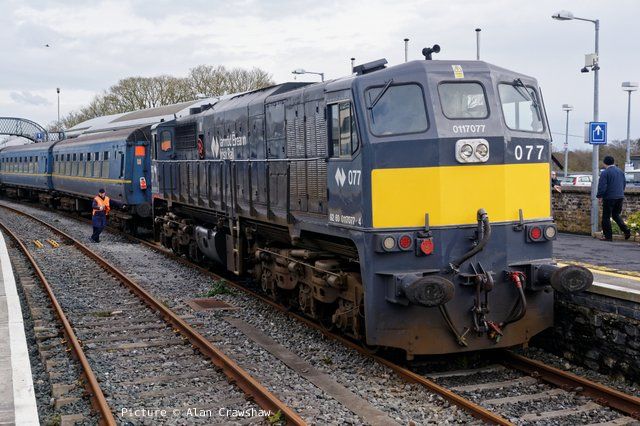
077, seen above at Killkenny, took over at Waterford but was in charge for less than an hour, 079 taking over at Kilkenny to bring us back to Dublin, saving another locomotive run-round. Such manoeuvres are more difficult following the removal of such facilities at stations which are now served only by railcars.
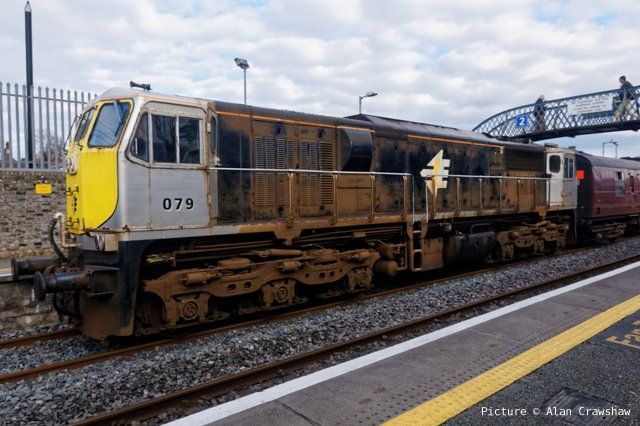
Above, 079 pauses at Athy en route to Dublin Connolly where we arrived on time soon after 19:00, an enjoyable tour with congenial company.
After an overnight stay in the capital we spent a very interesting morning visiting Kilmainham Gaol, which enhanced my understanding of Irish history, returning home on the 15:10 Stena ferry and the 19:21 Arriva service from Holyhead.
There's an interesting piece on the Western Rail Corridor on the Irish Times website.
Mixed trains on the Cambrian
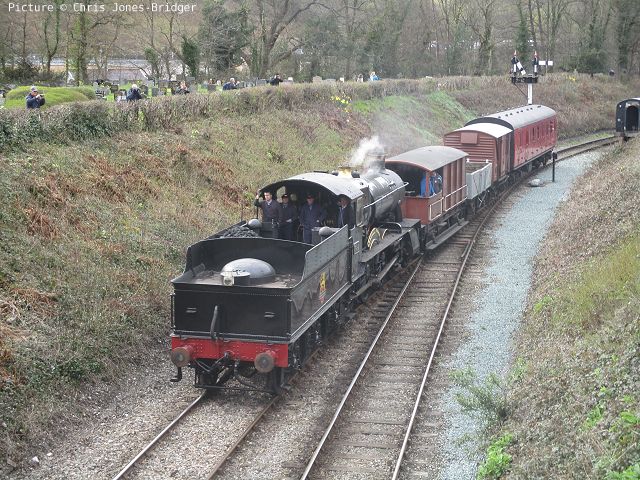
Thanks to all who responded to our question about the use mixed trains on the Cambrian lines in British Railways era, as portrayed in the recent Llangollen Railway gala. The picture above, by Chris Jones-Bridger and re-produced from our 11 April special issue, shows the train in question. One point noted by correspondents concerns the open wagon in the train which is painted grey (rather than bauxite brown like the other wagons), a colour which at the time portrayed indicated that the wagon was not fitted with hand-braked only and no vacuum brakes. If so, then passengers would not be allowed to travel in the coach at the rear as its brakes would have been rendered inoperative by the lack of a through vacuum connection from the loco. Comments from Llangollen insiders welcome.
The term 'mixed train' in UK railway usage refers to a train including both passenger coaches (carrying passengers) and goods wagons. It does not include trains including 'non-passenger coaching stock' such as mail or parcels vans, such as the 'York Mail' which used to run each night between York and Aberystwyth, carrying your editor on one memorable occasion. Sometimes empty coaches would be attached to goods trains, such as (away from North Wales) a well known example from the 1950s on the Stockport - Buxton line where a daily steam-hauled morning rush-hour train had two extra coaches added, which would have made the train too heavy to climb the gradient back to Buxton, so they were transferred at Manchester to a freight train for the (empty) return trip.
The very last British Rail mixed train (so far!) ran in the 1980s on the Fort William - Mallaig line, where tank wagons of trawler fuel were attached as required to a loco-hauled passenger service. The present structure of the privatised rail industry would seem to make a revival unlikely.
Robert Darlaston has kindly written the following summary of the Cambrian situation:
There were a handful of mixed trains in the area in early B.R. days, but so far as I can see all had ceased by the start of the 1960s. The Shrewsbury District Working Timetables for Summer 1962 show no such workings and the operating instructions at the back of the book merely contain a couple of sentences on calculating loads of mixed trains, applicable across the whole Western Region as such workings continued on, e.g., the Hemyock and Chard branches.
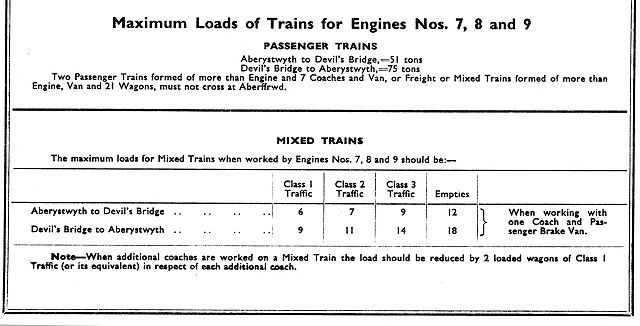
There is, however, a tantalising paragraph about operating mixed trains on the Vale of Rheidol branch and I attach a copy for general interest. One suspects that as freight operations on the line had long ceased, the instructions related merely to permanent-way maintenance trains which
might include a carriage for staff plus some wagons of ballast.
Even back in 1931, the G.W.R. Service Time Tables for the Chester District showed minimal evidence of mixed trains on the former Cambrian system. There were, however, some mixed workings on the Tanat Valley line from Oswestry to Llangynog which continued until the passenger service was withdrawn in 1951. There were no mixed trains listed then on other likely
candidates, such as the Llanfyllin, Wrexham - Ellesmere or Oswestry - Gobowen lines. There was, however, a daily mixed train on the G.W. Blaenau Ffestiniog branch (never part of the Cambrian system) which continued into B.R. days and was photographed in 1948 with loco 7431; see page 137 of Rails through Bala by Bodlander, Hambly, Leadbetter and Southern (Wrexham: Bridge Books, 2011).
A curious entry in the 1931 timetable is the 4.5 am Mail and Goods (Class F) from Ruabon to Barmouth, described as Mixed (Class B) from Dolgelley to Barmouth. That line was purely Great Western as far as Dolgelley, with only the section thence to Barmouth Junction being part of the Cambrian system. The 4.5 am from Ruabon is shown as stopping at Llangollen, Corwen, Bala Junction and Dolgelley, plus Llandrillo, Llandderfel and Llanuwchllyn for "Mail purposes only". The working was most unusual in not stopping at Barmouth Junction (which survives as Morfa Mawddach).
The Snowdonian - pictures by Jack Bowley
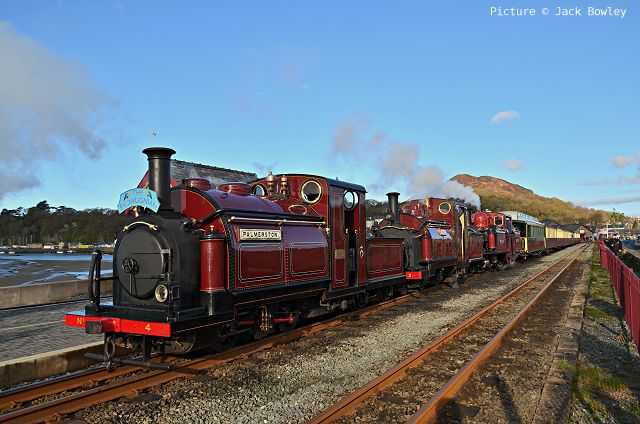
Some views of the 'Snowdonian' railtour at the Ffestiniog & Welsh Highland Railways on Saturday 16 April with its emphasis on triple-heading of trains, advertised as a chance to 'travel nonstop over nearly 80-miles of 2ft narrow gauge track through North Wales' finest countryside.' Above: Porthmadog Harbour Station with train for Blaenau Ffestiniog with Palmerston, Prince and David Lloyd George.
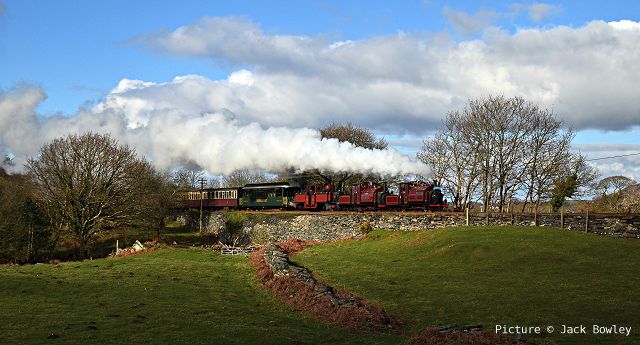
Gwyndy Bank, Minffordd.
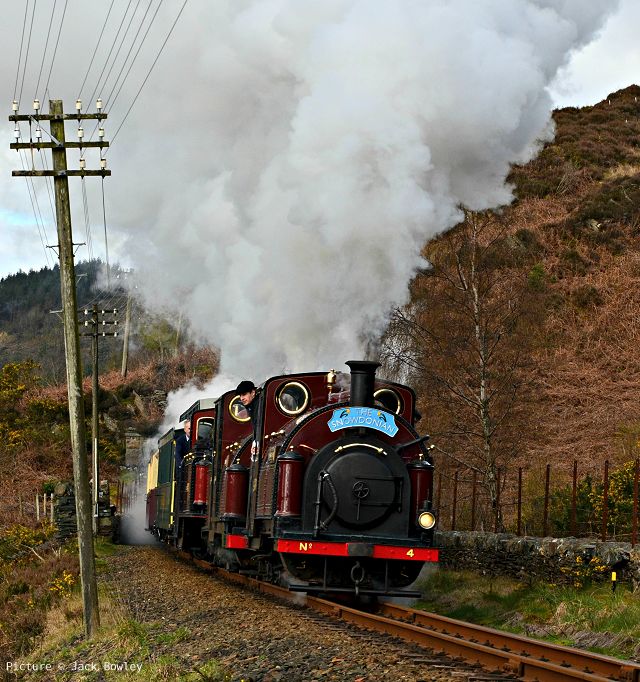
Garnedd Tunnel, Tan-y-bwlch
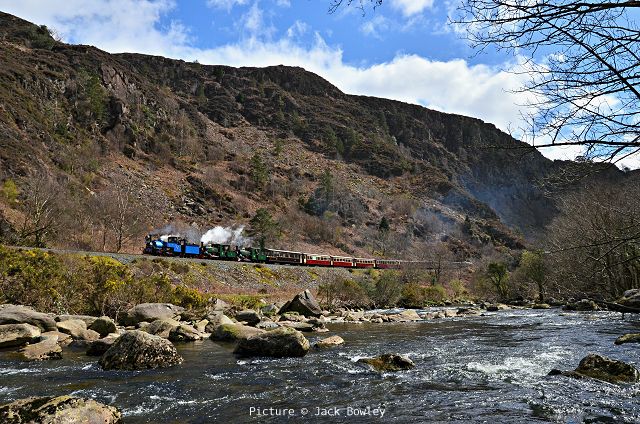
The Aberglaslyn Pass (train now for Caernarfon with Darjeeling 19B, Linda and Blanche)
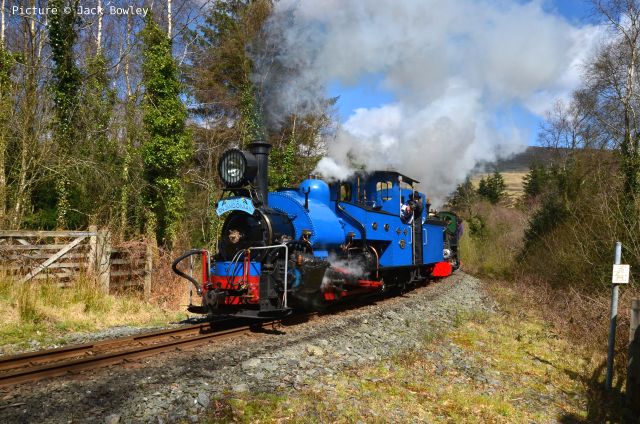
Canal Curve, Meillionen Camp Site
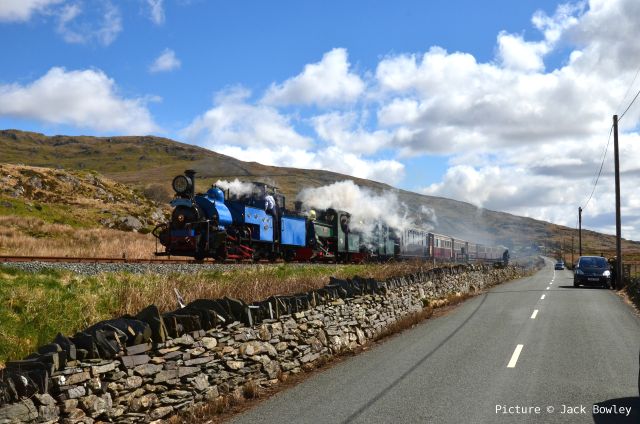
Rhyd Ddu.
Vintage traction morning at Warrington - report by David Parry
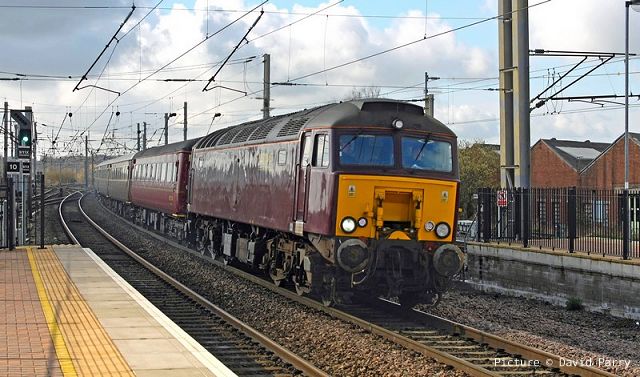
Having spent the previous day at the Llangollens Spring Gala, I felt something of a gala atmosphere at Warrington Bank Quay on Saturday 9 April as a number of special and regular workings combined to make it a particularly productive morning photographically. My original intention to photograph the down Tesco Daventry-Mossend intermodal was somewhat eclipsed by what was to follow. There were plenty of other photographers there, though I was struck by the younger than average age profile this was not an attraction for steam fans!
Close behind the Tesco express came a Newport-Carlisle Statesman railtour topped and tailed by class 57s, with 57 313 leading ...
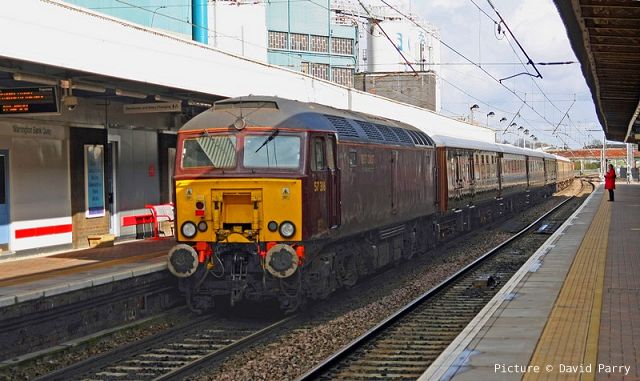
... while providing support at the back was 57316.
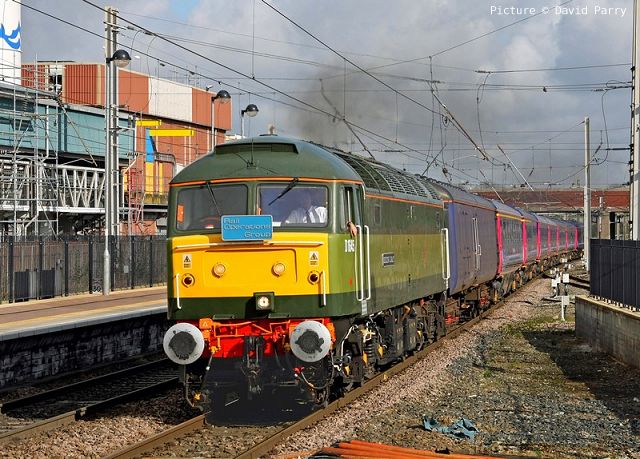
The vintage traction theme was continued by a Rail Operations Group charter from Kilmarnock to Plymouth Laira, headed by 47 830 (D1645) Beechings Legacy in near-original livery. This loco was named in 2015 to commemorate the 50th anniversary of Freightliners Ltd.
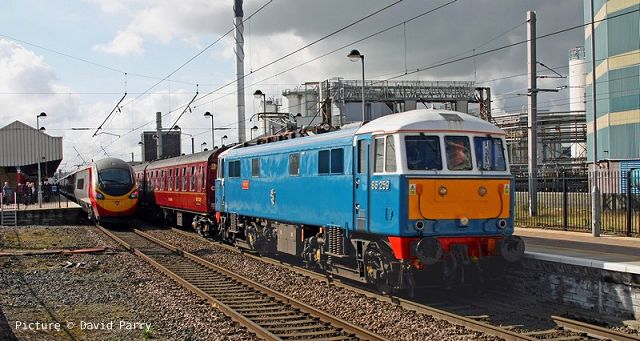
The next special was apparently the main attraction, which from my viewpoint appeared at speed from behind a Pendolino: 86 259 (E3137) Les Ross, on a Euston-Carlisle railtour.
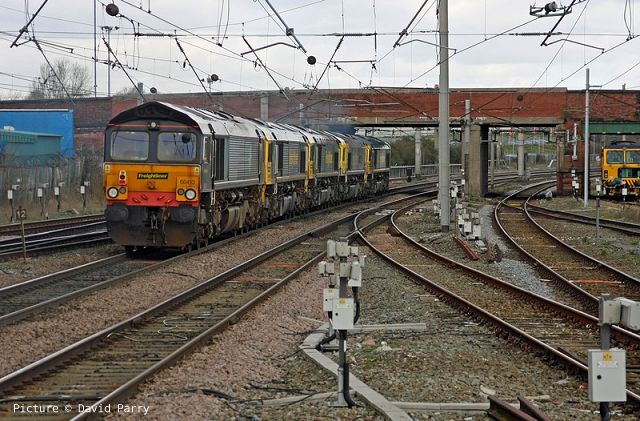
Next, and also appearing from behind an up train in platform 2, a convoy of five Freightliner class 66s appeared off-topic for this contribution, but worth including.
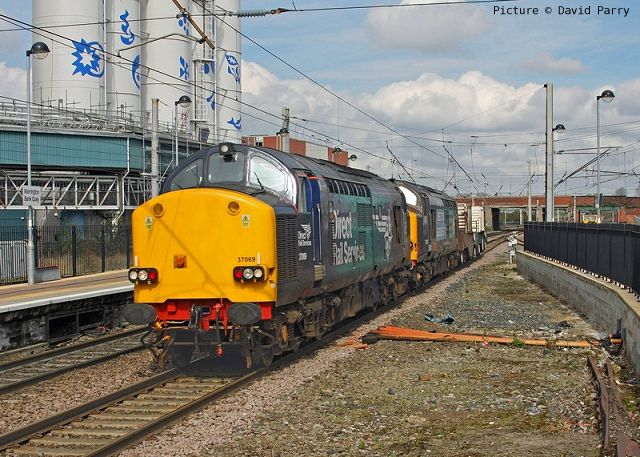
Finally, before heading back home, the bonus in this vintage traction feast a pair of class 37s on the Sellafield - Crewe flasks, with 37 069 leading. . So, three 47/57s, two 37s and one 86. Not bad for a mornings photography.
North Wales Coast home page | Archive | Previous Notice Board